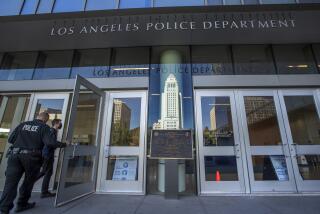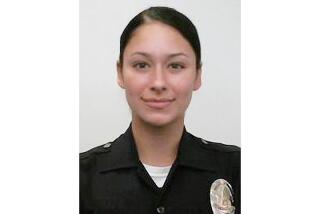Accidental Gunshots Vex LAPD
- Share via
The iconic confrontation in American policing, in which brave officers shoot it out with armed thugs, has occurred time and again in the annals of the Los Angeles Police Department.
Only days ago, what seemed like a routine traffic stop turned into a gun battle when officers pulled over a car only to see a passenger emerge with an AK-47 assault rifle. The gunman sprayed the squad car with about 20 high-velocity rounds, one of which nearly severed an officer’s wrist.
As unsettling -- and unpredictable -- as such incidents are, a Times analysis of two decades of police records highlights another danger to officers, one little appreciated even by officials who oversee the department: Officers over those years shot themselves or one another nearly as often as they were shot by suspects.
Since 1985, there have been more than 350 accidental discharges by LAPD officers. There also have been more than a dozen so-called friendly fire incidents.
Though the resulting wounds tended to be less serious than in gun battles with suspects, scores of officers and more than two dozen suspects and bystanders have been injured in incidents that department officials blame on careless handling of firearms.
“Any officer being shot for any reason is an unacceptable number,” said Police Commission Vice President Alan Skobin, who is one of two commissioners assigned to review accidental discharges of guns. “Unfortunately, when you have a large number of people who frequently handle weapons, there will be accidents. You just hope that there aren’t serious consequences.”
Last month offered up a sad example: The 3-year-old son of an LAPD officer got hold of his father’s 9-millimeter service handgun as they sat in a pickup truck at a traffic light in Anaheim. When the child pulled the trigger, a bullet passed through the officer and left him paralyzed from the waist down.
Officials say that kind of tragedy is rare, but department records don’t track accidental shootings not committed by an officer.
The vast majority of accidental shootings the department does monitor are avoidable and generally the result of careless or reckless conduct.
Over the last five years, the number of accidents has declined -- as have all types of officer-involved shootings -- but such incidents still accounted for about a third of all gunshot injuries sustained by officers.
Some officers have been involved in more than one accidental shooting. However, because the Police Commission this year started withholding the names of officers involved in shootings, it is no longer possible to determine from its public reports whether an officer has a history of negligently handling firearms.
Mishaps commonly occur as officers chase suspects or clean their guns. However, over the years, some accidental gunshots have been highly unusual.
One off-duty officer shot himself in a leg as he sat behind his desk and, according to department records, contemplated “a complex mathematical problem.” Another officer inadvertently pulled the trigger when his African gray parrot flew into his face.
One officer accidentally shot his girlfriend in a leg while trying to retrieve a cartridge from his handgun as a “memento” of their date. Yet another officer admitted that he accidentally fired his gun because he was startled by a woman holding a teddy bear. Two officers accidentally discharged their weapons as they handled them at home while watching themselves in mirrors.
Even officers from the department’s elite SWAT unit have accidentally fired guns while on duty.
In one case, officers had just completed a highly dangerous operation in which they entered the home of a barricaded suspect. Though they emerged from the house unscathed, one of them errantly fired his shotgun while unloading ammunition from another weapon. Shotgun pellets struck the ground between his feet, with metal fragments ricocheting into his partner’s upper leg.
In another case, an officer from the division that studies police behavior and attempts to reduce risk was off duty when he decided to give his fiancee a lesson on the safe handling of guns, according to a department report.
The officer thought he had removed all of the rounds from the cylinder of his .38-caliber weapon when he pointed it at a wall and began to explain “trigger pull pressure.” As he pulled the trigger, a round that had been left in the chamber discharged into the wall.
Accidental shootings are not unique to LAPD officers. Statistics from the Los Angeles County Sheriff’s Department show that deputies over the last five years accidentally discharged their weapons at roughly the same rate.
“I don’t see it as a problem any more significant than other agencies might have, and maybe, in fact, less significant,” LAPD Chief William J. Bratton said.
Police Department records show that 161 officers were injured by gunfire from 1985 to 2005, the last year for which statistics are available.
Ninety officers were shot by suspects, compared to 68 officers who either shot themselves or were shot by other officers. (In three cases it was unknown whether the officer was wounded by a suspect’s gun or by friendly fire.)
At the LAPD, accidental gunshots can mean administrative headaches and embarrassment for those involved. Officers are required to report immediately any discharge of a weapon whether it is intentional or not, on duty or off.
All gun discharges are investigated by detectives and then reviewed by the chief and the civilian Police Commission, which makes the final determination on whether a shooting is within departmental guidelines.
Nearly every accidental gunshot results in an “out of policy” finding by the commission and can result in an officer being disciplined. Often, however, they receive minor punishments such as reprimands.
Because of administrative repercussions, police experts suspect that many accidental shootings go unreported, especially if they occur while the officer is off duty, which according to LAPD records is when more than 20% of the accidents happen.
Former LAPD training Officer Hank Cousine admitted that he did not report an accidental discharge by a probationary officer under his supervision because he didn’t want to hurt the young officer’s career.
Cousine, a 15-year veteran who was fired for participating in an illegal pyramid scheme in 1998, said he believes that many accidental discharges go unnoticed by the department.
“If there’s no one around, you’re not going to say anything about it,” Cousine said. “Why would you lay yourself out? Why would you want to give up money, get yourself in trouble, and take days off and get ridiculed? Why would you do that?”
Over the years, alcohol appeared to play a role in some accidental discharges.
Officer Timothy J. McLaughlin accidentally fired a .38-caliber bullet through his apartment wall and into a neighbor’s home after drinking six beers in 1999. He reported the discharge a day later, only after learning that the neighbor took a photo of the bullet hole and talked to his landlord about hiring an attorney.
“A firearm must be handled with extreme care at all times; no one should be more aware of this than a police officer,” said Capt. Joseph Curreri, who recommended that McLaughlin be suspended for 15 days. “Only but for the grace of God was no one injured as a result of the accidental discharge.”
While drinking for several hours at a bar in Hermosa Beach in 1998, records show, officers Erik Cortes and Jeffrey Ingalls got to talking about guns and police tactics.
At one point, they went to the restroom together. As Ingalls washed his hands at a sink, Cortes saw Ingalls’ gun and removed it from its holster, accidentally shooting his friend’s hand. As the bullet shattered on the bathroom floor, a fragment ricocheted into Ingalls’ neck.
In a 1992 case, Officer John Duran had a blood alcohol level of 0.232 -- nearly three times the legal driving limit -- when he accidentally fired his gun, setting off a chain reaction of injuries.
According to police reports, Duran was a passenger in the backseat of a pickup truck when his gun fell out of his waistband. As he picked it up, one of his buddies started play-fighting, slapping the off-duty officer.
The gun went off and the bullet hit the driver in an arm, causing him to lose control and crash into a telephone pole. The collision broke Duran’s neck and fractured a leg of another passenger -- also an off-duty LAPD officer -- in five places.
“People make mistakes,” Commissioner Skobin said. “They are human beings. You wish it would never happen, but unfortunately it does.”
*
Times staff writer Doug Smith contributed to this report.
More to Read
Sign up for Essential California
The most important California stories and recommendations in your inbox every morning.
You may occasionally receive promotional content from the Los Angeles Times.










